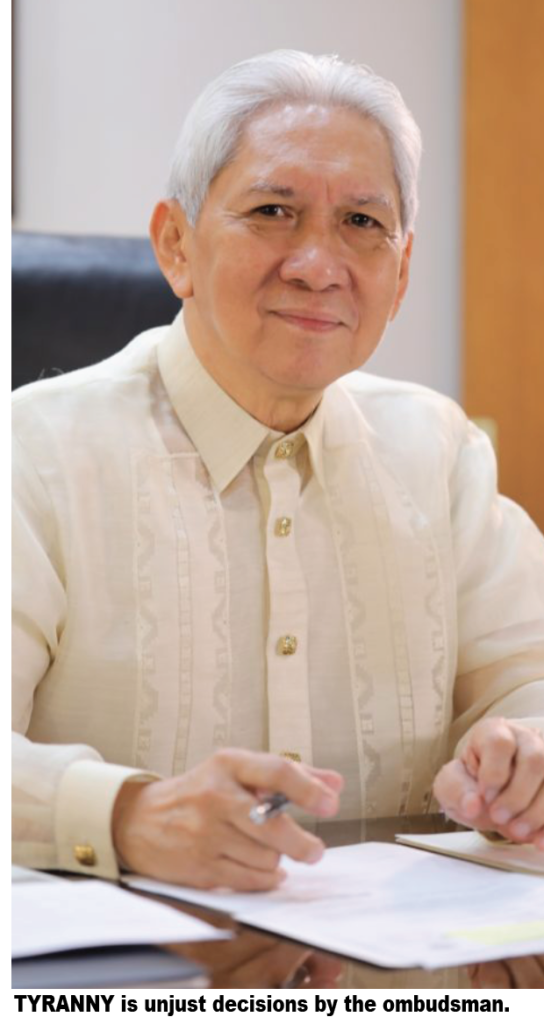By Tony Lopez
As we celebrate National Heroes Day, let me talk about tyranny.
The best way to enrage and outrage a people is through tyranny. Enrage is when you are made angry. Outrage is when you are accused falsely or unfairly, or done an injustice.
Tyranny is rank corruption at Customs and elsewhere.
Tyranny is unjust decisions by the ombudsman.
Tyranny is a police officer brandishing a gun and manhandling a cyclist for an imagined fault.
Tyranny is a fellow officer justifying the abuse with flippant contempt.
Tyranny is banning works of school kids from being posted inside classrooms.
Tyranny is a task force imposing unreasonable travel requirements when there should be none.

Tyranny is cronyism and rent seeking amid the world’s worst income inequality.
These acts of tyranny fester wounds of injustice.


Now, let me refer you to Encyclopedia Britannica for a discussion on the origin of tyranny, the meaning of tyranny and how it became a bad word:
“Tyranny, in the Greco-Roman world, an autocratic form of rule in which one individual exercised power without any legal restraint. In antiquity the word tyrant was not necessarily pejorative and signified the holder of absolute political power.
“In its modern usage, the word tyranny is usually pejorative and connotes the illegitimate possession or use of such power. “For the ancient Greeks, a tyrant was not necessarily a bad ruler; in its original form (tyrannos) the word was used to describe a person who held absolute and personal power within a state, as distinct from a monarch, whose rule was bound by constitution and law.
“Some tyrants were usurpers who came to power by their own efforts; others were elected to rule; and still others were imposed by intervention from outside.
“Certain rulers, such as Phalaris, tyrant of Akragas in Sicily, who allegedly burned his enemies alive in a brazen bull, were bywords for uncontrolled cruelty and self-indulgence; but others, such as Pittakos at Mytilene, were remembered favorably in later sources as wise and moderate rulers who brought prosperity and peace to their cities.
“Later on in classical history, the word gradually acquired more of its modern flavor, implying a ruler whose sole motivation was power and personal gain, and as a result its use in public life became controversial.
“Tyranny has thus been at the center of debate about legitimacy in rulership and the balance of power between ruler and people.
“Since Roman times philosophers have argued for the moral right of the citizen to overthrow a tyrant whatever the law and have debated the point at which monarchic rule becomes tyrannical.”
Classic definitions
“The best-known definition of tyranny comes from Aristotle’s Politics: ‘Any sole ruler, who is not required to give an account of himself, and who rules over subjects all equal or superior to himself to suit his own interest and not theirs, can only be exercising a tyranny.’
“Aristotle presents tyranny in a very negative light, as a form of monarchy that has deviated from the ideal, and by listing the characteristics of the tyrant – he comes to power by force, has a bodyguard of foreigners to protect him and rules over unwilling subjects – Aristotle suggests that a tyrant was always a violent usurper.
“Peisistratus, tyrant of Athens, is a classic example; he made three attempts to seize power, finally succeeding in a military coup in 546 BCE by using forces from outside, and ruled for 30 years.

“But tyranny was more complex than Aristotle implies. Peisistratus did not dismantle the structure of government, and assemblies of the people continued to be held and magistrates continued to be appointed under his rule. Most notably, he was succeeded by his two sons, Hippias and Hipparchos, turning the rule into a hereditary one.
“Some tyrants had power conferred on them by the state, such as Clearchus at Heracleia on the Black Sea, who was appointed in 364 BCE to resolve a civil conflict, whereas others, such as Mausolus and Artemisia of Halicarnassus (creators of the Mausoleum, one of the Seven Wonders of the Ancient World), ruled with tyrannical power but were in constitutional terms satraps (governors) within the Persian Empire.
“There were classical rulers who, for a long or short period of time, dominated a state and had the ability to do whatever they wanted – found cities, move populations, wage war, create new citizens, build monuments or accumulate money.

“Those rulers had certain fundamental features in common. They were sole rulers with direct and personal power over the state, unconstrained by political institutions. Their power was dependent not on a right to rule but on their own ability to command and retain control. All tyrants aimed to hand power on within their family, and some succeeded in establishing a rule lasting many generations.
“Tyrants were generally successful in government, bringing economic prosperity and expansion to their cities.
“The Aristotelian view suggests that tyrants were inevitably unpopular, ruling a cowed citizenry who feared and hated them and wished only to be free.
“But some tyrants were chosen by the state to rule with a specific purpose: to put an end to civil war, to impose a new code of law or to offer leadership in a time of danger. Indeed, it was often proposed that a sole ruler with overall control of military and political affairs was the best option in wartime.”
So there, when looking at acts of tyranny, remember these words – abuse of power, power by force, domination, illegitimacy, fear, a cowed citizenry.
And the best way to deal with tyrants? Defenestration. Throw them out of the window. Literally. And at times, violently, as the French did.
What happens when you defenestrate a tyrant? You are a hero.
— The Philippine Star, Aug. 29, 2023
